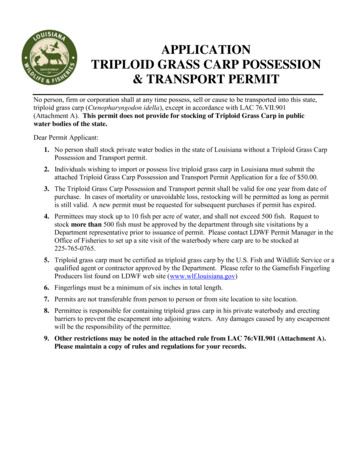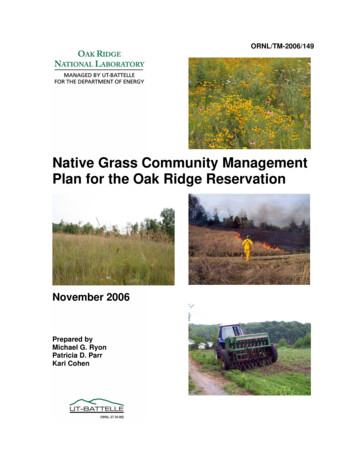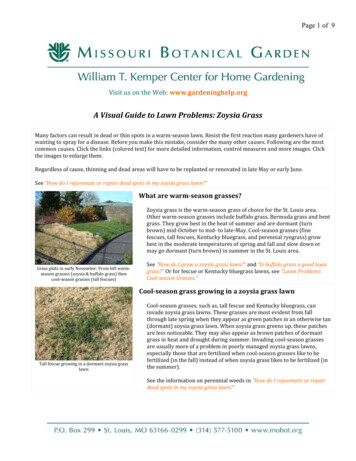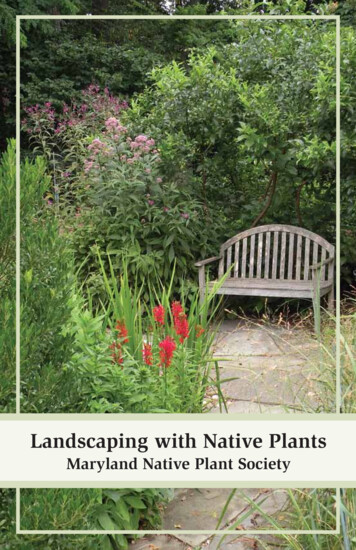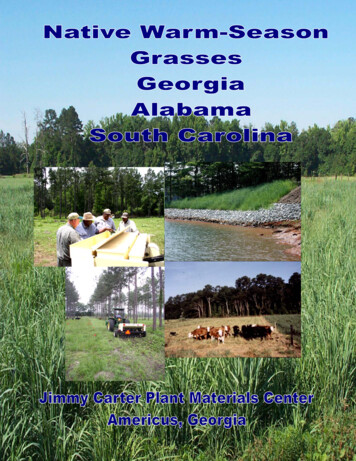
Transcription
CONTENTSINTRODUCTION .3IDENTIFICATION AND DESCRIPTION .4ESTABLISHMENT OF NATIVE WARM SEASON GRASSES .6Seedbed Fertility .7Seedbed Preparation.8Equipment Used For Seeding.8Seeding Rates .9Seed Quality .9RECOMMENDED VARIETIES OF NATIVE WARM SEASONGRASSES FOR USE IN GEORGIA, ALABAMA ANDSOUTH CAROLINA .10SPECIAL USES OF NATIVE WARM-SEASON GRASSES .13SEEDBED PREPARATION.14Fallow/Cropland Fields.14Woodland Edges .14Slopes Greater than 8 Percent .14Planting Date, Seeding Rates, Fertilizer and Lime .14MANAGEMENT OF NATIVE WARM SEASON GRASSES.14Grazing Management .14Hay Management .15Prescribed Burning.15Weed Control .16USING NATIVE WARM-SEASON GRASSES FORWILDLIFE HABITAT .17Importance of open structure .17Importance of forbs and shrubs .18Winter Cover .19Managing Native Warm-Season Grass Fields for Wildlife.19Burning .19Seed quality and estimating PLS .20Seed dormancy.20Mixtures.21Evaluating success- what to expect .22Seeding rates and mixtures .23NATIVE GRASS DRILLS.231
Native Warm Season GrassesforGeorgia, Alabama and South CarolinaDonald SurrencyProgram ManagerPlant Materials SpecialistThomson, GeorgiaThis resource guide serves as a tool for selecting and establishing native warm seasongrasses in Georgia, Alabama and South Carolina. The guide is a description of native warmseason grasses that are adapted to Southeastern conditions. The plant materials technologyincludes information on optima seeding rates, management, using native grass drills andconventional drills for switchgrass and eastern gamagrass seed. The guidelines in thisdocument are to be used by NRCS Field Offices to supplement the field office technicalguide (FOTG) regarding native grasses. This guide is an evolving document that will beupdated as new information is available and as new plant materials are developed and testedat plant materials centers.Plant Materials ProgramMarch 2006, Rev. 12
Donald Surrency, Plant Materials SpecialistUSDA – Natural Resources Conservation ServiceCharles M. Owsley, Plant Materials Center ManagerUSDA-Natural Resources Conservation ServiceINTRODUCTIONHistorically, all forage production and landscape cover in the area east of the Mississippi Riverhas been accomplished through the use of introduced grasses and legumes. In the NortheasternUS species from the European or Mediterranean areas have predominated, while species oftropical or subtropical origin have been commonly used in the Southeastern US.In recent years interest in the use of a number of native grasses has increased. Species ofinterest include: switchgrass (Panicum virgatum), indiangrass (Sorghastrum nutans), easterngamagrass (Tripsacum dactyloides), big bluestem (Andropogon gerardii), and little bluestem(Schizachyrium scoparium). These grasses are currently used on rangeland and plantedpastures in the West Central United States. It has been proposed that these grasses havepotential for pasture, hay, erosion control, biomass, wildlife habitat, and as a plant material forriparian buffer strips in the Southeast. A significant amount of data on native warm seasongrasses has been accumulated by USDA-Natural Resources Conservation Service, PlantMaterials Centers in the Southeast. Much of this has been oriented toward erosion control,grazing land, wildlife, establishment, and management.The use of native warm season grasses has become a top priority across the nation. NRCShas emphasized their use in several programs, such as, CRP and WHIP. However, manyfield office personnel are unfamiliar with the most widely used native grasses such asswitchgrass, indiangrass, big bluestem, little bluestem, and eastern gamagrass.Native warm season grasses have the potential of producing forage for small farmers in theSoutheast with less commercial nitrogen (N) fertilizer in a low-input system.3
IDENTIFICATION AND DESCRIPTIONOf the many native warm season grasses, switchgrass, big bluestem, indiangrass andeastern gamagrass show the most potential for the southeast. All are called warm seasongrasses because of their adaptation to warm day climates, but they differ in their seasonalproduction of forage. In general, eastern gamagrass and switchgrass greens up and matureearliest, while big bluestem is intermediate and indiangrass matures latest. Unlike tallfescue and other cool season grasses, warm season grasses are most productive from Juneto early September. Therefore, a combination of separate cool and warm season pasturescan be managed to supply a more constant supply of high quality forage throughout theseason than either cool or warm season grasses alone.Native grass seedlings have very low vigor and do not compete well with weeds.Consequently, switchgrass, big bluestem and indiangrass are moderately difficult toestablish and may need two years before they can be hayed or grazed. In exceptionalyears, plantings may establish well enough to allow grazing in the first year.Warm season grass pastures will not withstand continuous, close grazing or close clippingwithout reducing yield the following year. Rotational grazing is necessary to maintainproductive warm season grass stands.In return for careful management, a farmer can produce two to four tons of forage per acreon well-fertilized, warm season grasses between late June and early September. Assuminga mature cow requires 30 pounds of forage per day, one acre of warm season grass cansupply sufficient forage for two cows during the summer. During low rainfall or longdrought periods, native warm season grasses provide forage for grazing.Big Bluestem (Andropogon gerardii)Big bluestem is a warm season, rhizomatous,perennial bunch grass 4 to 6 feet tall. One ofthe best features used to identify this grass.Leaf blades are long and flat. Seedheadsconsist of 2 to 3 distinct racemes on top of thestem and resemble the toes of a turkey’s footwhich suggests another common name,turkey-foot grass. The seedhead has threeracemes that resemble a turkey’s foot. Seedare relatively dark and hairy. Big Bluestemgrows on a wide variety of soils and isextremely drought-tolerant, with root systemsthat may grow 12 feet deep. Big bluestemprovides excellent wildlife habitat and qualityforage for livestock.Big Bluestem4
Eastern gamagrass (Tripsacum dactyloidesEastern gamagrass is a robust warm-season,rhizomatous perennial grass that grows from 5 to 9feet in height. It may reach 6-8 feet in height,producing conspicuous stools up to 4 feet indiameter. Over time, stool size increases with ageand the center will lack stems and leaves. Easterngamagrass will grow to 5-9 feet tall. The seadhead iscomprised of two or three terminal spikes 6-10inches long. Leaf blades are 12 to 24 inches longand 3/8 to 1/2 wide, flat and have a pronouncedmidrib. Eastern Gamagrass is extremely deep-rootedand drought tolerant. It grows best on relativelymoist, well-drained fertile soils, but does not toleratestanding water for long periods. ‘Highlander’ ‘Pete’and ‘Iuka’ are cultivars well suited for Georgia,Alabama and South Carolina. Cattle like it so well,grazing should be closely monitored to keep standfrom being grazed too hard. 'Pete' can produce up to16,000 pounds of dry matter per year.Eastern GamagrassIndiangrass (Sorghastrum nutans)Indiangrass is a rhizomatous, perennial warm seasongrass. It attains heights of 4 to 7 feet. Indiangrass istypically 4 -7 feet in height. Leaves are flat andnarrow at the base, growing 10-24 inches long. Theseedhead is golden bronze to yellow, 6-12 incheslong, and usually formed in late August. The seedare tan and very fluffy. Indiangrass produces a deeproot system and is quite drought-tolerant.Indiangrass provides quality wildlife habitat andquality forage for livestock.IndiangrassLittle Bluestem (Schizachyrium scoparium)Little bluestem is a warm season bunch grass that isperennial and grows between 2 and 4 feet in height.Leaf blades are flat and are from 6 to 10 inches longand 1/8 to ¼ inch wide. The stem is flattened at thebase and often red or purplish during early growth.Mature plants are reddish-brown. Little bluestemseed also appear hairy. Little bluestem grows on aside variety of soils and is one of the most attractivegrasses in summer and fall. Little bluestem providesquality wildlife habitat and has great potential forlandscaping and erosion control on poor, droughtysoils. It is an important forage grass that is grazedreadily by livestock, deer. Small game, such as,rabbit and quail can be found in stands of this grass.Little Bluestem5
Switchgrass (Panicum virgatum)Switchgrass is a warm season, rhizomatous,perennial grass that ranges in height from 3 to 6feet. Switchgrass typically reaches 3-6 feet ineight. Switchgrass is an early-maturing warmseason grass, flowering in early to mid June.Switchgrass is adapted to a wide variety of soilsand site conditions. With an extensive rootSwitchgrasssystems, switchgrass is extremely drought–tolerant, but also does well on relatively wetsites with at least one cultivar (‘Kanlow’) tolerant of extended flooding. Seed fromswitchgrass are small, smooth and hard, somewhat resembling millet in size and color.There are many cultivars of switchgrass. ‘Kanlow’ (uplands and lowland) and ‘Cave-inRock” (uplands are well suited for wildlife cover and livestock forage. It is a bunch grasswith flat leaf blades about 1/2 inch wide and 30 inches in length. It is a good cover plantfor birds and some small game. 'Alamo' is a good forage on sites in coastal plain andPiedmont regions. It can be used for forage, conservation buffers, streambankstabilization, filter strips and wildlife.ESTABLISHMENT OF NATIVE WARM SEASON GRASSESNative warm season grass may need special attention given for purchasing and plantingseed, and for management of established stands. The following features are important tonote which make warm-season grass planting different from other traditional plantings: Planting rates for warm season grassesare based on pure live seed (PLS) lb/acreand NOT bulk lb/acre. All warm-season grasses require a firmseedbed for best establishment. Traditional seeding equipment workswell for switchgrass and easterngamagrass, but fluffy-seeded speciessuch as big bluestem, little bluestem andindiangrass require special equipmentand/or techniques for successfulSwitchgrass (Panicum virgatum)seedings.6
PURCHASING SEEDIt is best to purchase certified seed of varietiesadapted to the region of planting. Certified seed isguaranteed to be true to a variety, and use ofcertified seed may lead to a more reliable planting.It is best to order different species and varietiesseparately instead of pre-mixed because seedingand management specification will differ betweenspecies.Warm season grass species should be purchased ona pure live seed (PLS) basis. Do not confuse 12 lbPLS/acre with 12 bulk lb/acre. Failure torecognize PLS when purchasing seed and figuringseeding rates may yield unexpected results.Planting Eastern gamagrass at the JimmyCarter Plant Materials Center.TIME OF SEEDINGWarm season grasses are best established duringMarch through May. Early planting is criticaleven though warm season grasses do not germinateuntil soil temperatures are above 50 to 55 degreesF. Avoid planting after June 1 because moistureand weed competition may delay standestablishment.Eastern gamagrass 3 months afterplanting.Early establishment allows seedlings to developgood root systems before summer drought andgreatly increases the ability of the grasses tocompete with weeds. Irrigation (if available)should be applied when soil conditions are verydry to enhance seed germination and standestablishment.Native grass seed typically contains higherpercentages of dormant seed than cool seasonforages. Planting early into cool soil will chill theseed and may help dormant seed to germinate.SSeeding into warmer soil in late spring can behelpful in controlling weeds. The first flush ofweeds is allowed to germinate and then is killed byfinal tillage or contact herbicide just prior toplanting. Ideally, this practice would result in theshortest period of bare ground and would get grassseedlings up as quick as possible to compete withother weeds.Eastern gamagrass InterCenter StrainTrial (clipping in progress) to determinedry matter production from 13 accessionsand one standard called 'Pete'. The drymatter yield for all accession averaged13,726 lbs./Ac. One accession fromMontgomery, AL produced 17,000 lbs./Ac.of dry matter yield.7
SEEDBED FERTILITYWarm season native grasses can be productive on low fertility soils, but fertilization willincrease plant vigor. Soil test the field prior to planting or cultivating. The pH should beadjusted to a range of 5 - 6 if needed. Incorporate lime in the fall to allow it time to adjustpH before planting in the spring. Fertility up to medium levels for phosphorous (P), andpotassium (K). Incorporate P and K into the soil at planting time. Do not apply nitrogen(N) at or before planting time. Nitrogen and phosphorous have been shown to increaseproductivity. However, nitrogen promotes weed growth, as well. Unless weedcompetition is low, N should be excluded the first year until a stand becomes established.The only exception for N application is planting critical sites, such as log decks, log roads,skid trails and other impoverished soils.In addition to the above guidelines, follow the fertilizer and lime recommendation in yourstate. Consult your Field Office Technical Guide (FOTG) for more specific informationbased on site and soils.SEEDBED PREPARATIONNative warm season grasses are best established by creating a tilled, firm seedbed. It isbest to remove all vegetative cover through the use of approved herbicides or extensivetillage. Seedbeds should be adequately plowed, disked and packed prior to planting. Acultipacker works well for firming the seedbed. If a prepared hard seedbed is rained onbefore planting, harrow and cultipack again before planting.EQUIPMENT USED FOR SEEDINGIdeally seed will be drilled into a prepared seedbed. Switchgrass may be planted with aconventional drill because it has a hard, smooth seed coat. Conventional drills equippedto seed alfalfa work well. Eastern gamagrass seed is about the size of corn seed and isbest planted with a corn planter. Big and little bluestem and indiangrass seed haveappendages with fine hair and will not pass through conventional equipment unless theycan be ordered as "debearded" or brushed seed. Debearded seed may pass through aconventional drill, though it may still be best to use a special drill designed for fluffy seed.Seed drills advertised as "native grass drills", such as a Tye or Truax drill, have specialboxes equipped with picker wheels and augers which help prevent seed from stickingtogether and move the seed to the drilling mechanism. Native seed drills have multipleboxes, which allow for the planting of both switchgrass and fluffy seeded species at thesame time. Switchgrass, indiangrass, and big and little bluestem should be seeded at 1/4to 1/2 inch deep. In sandy soils be especially careful not to bury seed too deep! Easterngamagrass is usually seeded at 1/2 to 3/4 inches deep. Planting native grasses withconservation tillage equipment is not recommended at this time.If a seed drill is not available, seed may be broadcast over a site. Broadcast fluffy seed(bluestem and indiangrass) with a drop spreader or cyclone spreader and then drag tolightly cover seed. If you are using a cyclone spreader, try mixing seed with inert mattersuch as kitty litter or sawdust for better spreading. Successful broadcast seeding can beachieved by increasing seeding rate and by rolling or cultipacking before and afterseeding. When planting a small area (1/4-acre) in droughty conditions, an optional step toenhance the stand would involve lightly mulching the seeded area.8
SEEDING RATESWarm season grasses species vary in their growth characteristics. This makes itmore difficult to manage mixtures for pasture or hay use, so only one speciesshould be seeded per field. In areas planted for wildlife and erosion control themanagement of mixtures is not as critical. Information is being developed onthe use and adaptability on establishing native grasses in mixtures.Seeding rates for pasture and hay, wildlife, critical area treatment andconservation buffers are found in the Tables 1 and 2.Table 1: Seeding rate for species planted aloneSpeciesBig bluestemLittle bluestemSwitchgrassIndiangrassEastern 0Pounds of Pure Live Seed (PLS) per AcreForageWildlife*BuffersCritical Area7378737862101073881471414* For best results plant with mixed species listed in Table 2.Table 2: Seeding rate for mixed species plantingsPounds of Pure Live Seed (PLS) per AcreSpeciesSeeds/lb.ForageWildlifeBuffersCritical AreaBig bluestem165,00041.547Little angrass175,00041.537Eastern gamagrass*ForbsTotal lbs PLS / Ac.7,800**NA15**1-35.54NA17**NA26* Switchgrass and eastern gamagrass should not be pre-mixed with fluffy-seeded species** Eastern gamagrass is best when used alone for these applicationsSEED QUALITYWarm season grasses can be quite variable in germination rate and the purity ofseed. Pure Live Seed (PLS) should always be used when purchasing seed and todetermine the bulk amount of seed necessary for a planting. It may be necessaryto increase your seeding rate to provide the recommended rates of pure live seed.Read the seed tag to determine contents of the bag and seed quality. From the tagyou can obtain information on % germination, % inert material, % other seed,and % weed seed. With this information you can compute the percent pure liveseed and pounds of bulk seed required.9
RECOMMENDED VARIETIES OF NATIVE WARM SEASON GRASSESFOR USE IN GEORGIA, ALABAMA AND SOUTH CAROLINABig bluestem'Rountree'Preferred variety for hay production, adapted to the southeast,good seedling vigor and forage productivity. Matures two weeksearlier than 'Kaw'. Origin: Iowa. Recommended for wildlifeplantings in a mixture (3 lbs PLS/ac) with other native grasses.'Kaw'Preferred pasture variety; adapted in most of the southeast,especially to drought sites. Not recommended as a pure stand butin a mixture (3 lbs PLS/ac) with other native grasses.Origin: Kansas.Little bluestemCimarronPreferred variety for wildlife plantings. Adapted to the southeast.AldousNot well adapted in most of the southeast. Can be used forwildlife plantings in a mixture with other native grasses. Notrecommended for forage. Demo plantings in South Carolina havebeen successful.Indiangrass'Lometa'Preferred variety for the southeast. Good seedling vigor andsuperior forage production given normal rainfall. Survival andproduction is better than 'Rumsey' and 'Cheyenne' at the JimmyCarter Plant Materials Center. Recommended for forage, buffers,wildlife plantings and critical areas.'Rumsey'Survival and production not as good as 'Lometa'. Notrecommended as a pure stand but in a mixture with other nativegrasses for forage. Can be planted in mixtures for wildlifeplantings.'Cheyenne'Not a certified variety, although noncertified seed is available.The performance in most of the southeast is not as good as'Lometa' or 'Rumsey'. Recommended use is in mixed stands forwildlife plantings on drought sites. Not recommended for forage.'Oto'Not well adapted in most of the southeast. Can be used forwildlife plantings in a mixture with other native grasses. Notrecommended for forage. Origin: Nebraska.10
‘Americus’It is a native of the southeast (Georgia and Alabama).It has a wide range of adaptation and performs betterthan 'Lometa' in most sites in the southeast. Competeswell with 'Pensacola' bahiagrass. Performs better thanbahiagrass on drought sites. Recommended in purestands. Conservation uses include: forage, buffers,wildlife, urban landscapes and critical areas. Thisaccession is scheduled for release in 2-3 years. It is theonly indiangrass variety that is native to the southeast.Eastern gamagrass'Pete'Adapted to most of the southeast. It can be used forforage, silage, hay, nutrient reclamation from lagoonsand municipal spray fields because of good nitrogenand phosphorus uptake. Used for urban conservationduring the 1996 Atlanta Olympics for beautificationand erosion control. Can be used for conservationbuffers.'Iuka''Iuka' is a new variety and its full range of adaptationis unknown at this time. The plant materials centershave established plantings to determine theperformance and adaptation in the southeast. Pete isthe preferred variety at this time.‘Highlander’‘Highlander’ is a new variety that is adapted for use inthe eastern part of the United States. It can be used forforage, erosion control, wildlife habitat, and waterquality improvement.‘San Marcos’‘San Marcos’ was originally collected in 1964 from anative stand in Hays County, Texas near the town ofSan Marcos. San Marcos is a tetraploid adaptedthroughout much of Texas and southern Oklahomawhere low land types of eastern gamagrass arecommonly found. It may be produced successfully inareas of lower rainfall (less than 28") if grown undersome type of irrigation system. Its forage value ishighly palatable to all livestock and must be managedaccordingly to avoid overgrazing.Switchgrass'Alamo''Alamo' switchgrass is highly recommendedthroughout the southeast. It has been fully tested forconservation uses and is recommended for forage,buffers, wildlife plantings, critical area treatment,shoreline and streambank stabilization and nutrientreclamation.11
'Cave-In-Rock''Cave-In-Rock' is recommended in the northern portion of theSoutheastern Region. Not as good on critical sites as'Alamo'. Adapted to lowland and upland sites with goodpalatability and animal gains. More dormant seed than'Blackwell' and tends to be slow to establish. It is a goodvariety for wildlife plantings.'Blackwell'Not well adapted in the lower southeastern portion of theSoutheastern Region. Can be used in mixed stands forwildlife plantings. Less forage production than 'Cave-InRock. Fine stemmed and rust resistant'Shelter'Adapted mostly for wildlife plantings. Notrecommended for forage and/or erosion control.MiamiStuartWabasoThese relatively new pre-varietal releases (sourceidentified) which are adapted for use in Florida. Theconservation uses include forage, wildlife and criticalarea treatment. These releases are establishedvegetatively.12
SPECIAL USES OF NATIVE WARM-SEASON GRASSESErosion ControlOn critical areas, warm-season grasses will controlerosion. They will provide low maintenance coveron banks and roadsides of state and U.S. highways.Excellent for streambank stabilization andconservation buffers. Native grasses can be usedsuccessfully for critical area treatment for urbanconservation.Photo 1 Switchgrass Buffer- conservation buffer/filterstrip reduces erosion from adjacent croplands. Use ofswitchgrass instead of fescue in a filter strip vastlyimproves it for wildlife cover while retaining all of theerosion control ability.12Photo 2 Alamo switchgrass is used for streambankstabilization at Thurmond Lake in South CarolinaPhoto 3 Eastern gamagrass used for municipalwastewater Sprayfield in Bellview/Perry located inMarion County, near Ocala, Florida.Photo 4 Jones Urban Farms Representativeobserves/evaluates harvest stage of Sunflower plants inAlabama. Native grasses are used with Sunflowers in acut-flower arrangement.3413
Wildlife HabitatWildlife biologists and upland game managers usewarm-season grasses for game habitat, nesting andholding areas. The stubble of the grasses remainsprotected “trafficways”. Little bluestem, bigbluestem and indiangrass are usually in these seedingmixtures.For wildlife plantings on fallow and cropland fieldsand woodland edges use the planting informationprovided below.Wildlife planting – Mixture ofswitchgrass, little bluestem, andindiangrass plants for wildlife aftera clear-cut in Abbeville, SouthCarolina.SEEDBED PREPARATIONFallow/Cropland FieldsTill soil to a depth of 3 inches prior to seeding. Follow the procedures described abovefor seedbed preparation.Woodland EdgesEstablishing food plots along woodland edges can be difficult due to compacted soilsand tree roots. Till soil or disk the area to a depth of 3 inches or as much as possible toloosen the soil. Broadcast seed and cultipack to ensure good seed soil contact.Slopes Greater than 8 PercentDisk area lightly, no less than 2 inches. Broadcast seed and cultipack to ensure goodseed soil contact. Area must be mulched to prevent erosion and loss of seed. Mulchshould be applied on slopes at a rate of 1000 lbs/Ac.Planting Date, Seeding Rates, Fertilizer and LimeProcedures described above for planting dates, seeding rates and fertility should befollowed. The only exception is on highly erodible sites and sites with very poor sterilesoils. On these sites use 40 to 60 lbs./Ac of nitrogen to promote growth.MANAGEMENT OF NATIVE WARM SEASON GRASSESGrazing ManagementInitial grazing of native warm season grasses in the early summer should not begin untilthe plants are 12 to 15 inches tall. Plants may be grazed no lower than 8 to 10 inches.These are tall grasses and the taller the plants are maintained the more vigorous theforage production that you will have. Grazing lower than 6 inches will result in plantswith less vigor. You can graze the plants somewhat more intensely in the late spring toearly summer as long as you reduce the grazing pressure in time to permit growth backto 12 inches in late summer and give the grass some rest in the fall. A rest in the fallbefore frost will provide for a vigorous start the next year.14
Rotational grazing (grazing differentfields) is recommended to reducetrampling and enhance utilization. A 4 to6 week rest period allows grasses torecover and light regrazing can occur. Ina rotational grazing system regulate toavoid regrazing new regrowth. Theduration of grazing of an individualpaddock or field should not exceed 1week.DO NOT GRAZE WARM SEASONRotational grazing demonstration at the JimmyGRASSES AS CLOSE TO THECarter PMCGROUND AS TALL FESCUE ORYOU WILL DAMAGE THE STAND.YOU WILL GET MAXIMUM PRODUCTION WITHMODERATE GRAZING INTENSITY.Hay ManagementSwitchgrass should be hayed in the late boot stage (usually mid to late June). Bluestemreaches this stage in early to mid July. This produces the best compromise between hayquality and tonnage. It allows regrowth prior to frost, replacing energy reserves in the rootsso that the stand can produce a vigorous growth the following year. At the same time, itpermits adequate regrowth that can provide wildlife with good winter cover. Gamagrass canbe hayed up to three cuttings (early June, July and August); however it needs 45 days restbefore first frost. DO NOT cut hay stubble lower than 8 inches to allow the grass to make amore rapid recovery to maintain a healthy stand. If you are emphasizing wildlife in thehaying operation, consider leaving a band of unmowed grass adjacent to woody cover,fencerows and drainage corridors.Prescribed BurningNative warm season grasses areespecially well adapted to managementwith
potential for pasture, hay, erosion control, biomass, wildlife habitat, and as a plant material for riparian buffer strips in the Southeast. A significant amount of data on native warm season grasses has been accumulated by USDA-Natural Resources Conser
